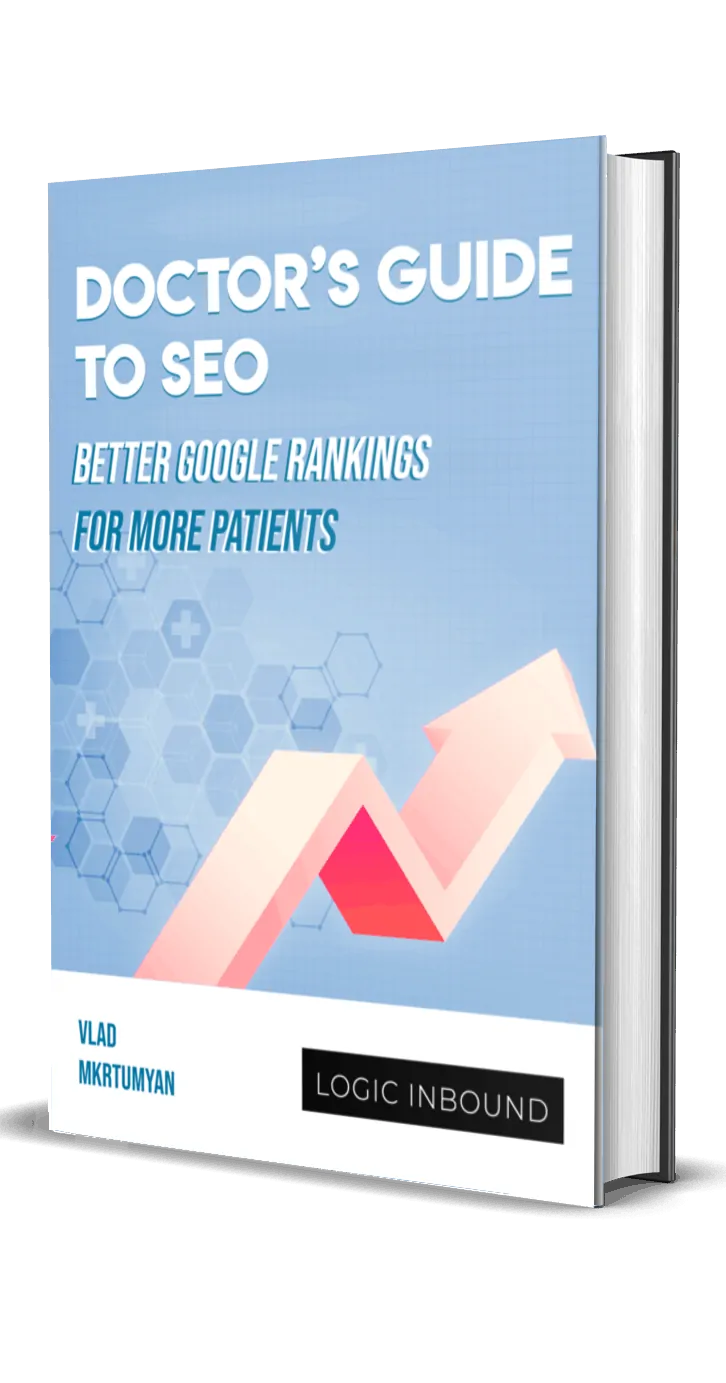You’re doing everything right. You’ve got the blog. The meta tags. The keywords. Maybe even a video or two. Yet somehow… no traffic turns into real leads. Or worse, people visit your site and bounce faster than you can say “algorithm update.”
Here’s the truth:
Ranking isn’t the same as converting. That’s why you need a real SEO funnel, one built for how people search and how Google thinks in 2025.
And no, it’s not some fluffy marketing buzzword. A solid SEO funnel walks your ideal customer from “What is this?” to “Take my money,” step by step, click by click. We’ve seen this work for everything from roofers to surgeons to SaaS founders. When it’s dialed in, it feels like magic. But it’s not magic. It’s just strategy + structure + intent.
The problem? Most websites don’t even know where their funnel starts, let alone where it’s leaking. If that’s you, don’t sweat it. You’re not alone.
And you don’t have to guess. We built a 5-stage funnel framework that’s designed for the way search works now, with AI Overviews, zero-click SERPs, and disappearing CTRs all baked in. In fact, over 60 % of Google searches on mobile now end without a click, and AI Overviews already appear in more than 13 % of queries, numbers that demand visibility on the SERP itself
Ready to turn traffic into booked calls?
Grab your free SEO audit here and we’ll show you what your funnel’s missing and how to fix it.
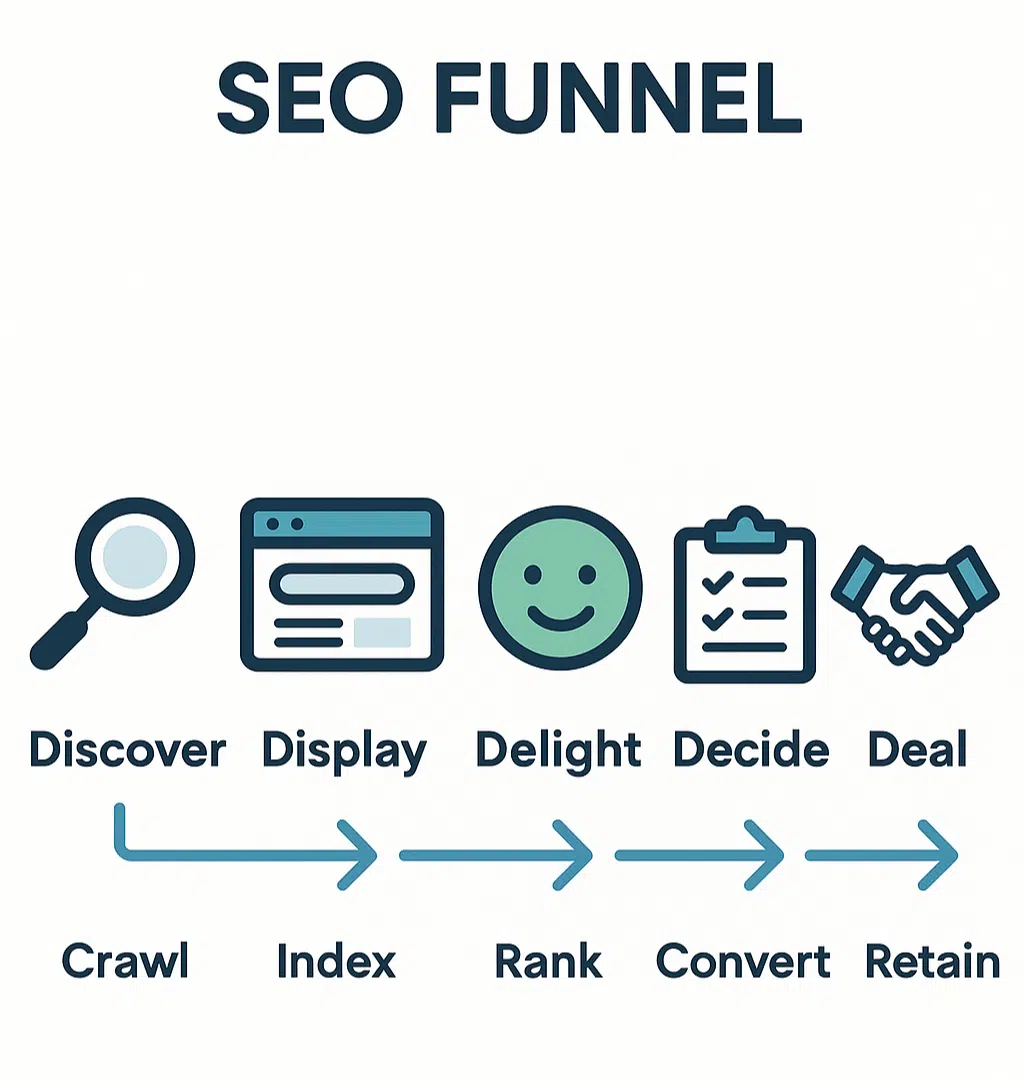
What Is the SEO Funnel & Why It Matters Now
An SEO funnel is the path someone takes from searching a question to becoming your customer. Simple, right? Not so fast.
In 2025, Google doesn’t just list links, it answers questions directly, often without sending users to your site at all. In fact, since Google launched its AI-powered answer overviews, the share of zero-click searches jumped from 56% to 69%. That means your content has to do more than rank; it has to match search intent at every step: awareness, research, decision, and action.
The best SEO funnels guide users like a good salesperson would:
- Top of funnel: Solve a problem.
- Middle of funnel: Show options.
- Bottom of funnel: Make it a no-brainer.
From a technical side, the funnel starts with Google crawling your content, deciding if it’s worth indexing, and maybe featuring it in an AI Overview. If your pages aren’t structured to support that journey, you’re out of the race before it begins.
We broke down all five stages of the SEO funnel so you can fix leaks, capture more qualified leads, and actually get ROI, not just rankings.
Bonus: If you’re wondering why your business isn’t even showing up on Google, this quick fix guide might be the best place to start.
2025 Reality Check: AI Overviews & Zero-Click SERPs
Remember when ranking #1 actually meant something? Those days are gone.
Now, over 60% of searches on mobile end without a single click. Why? Because Google already gave away the answer in a shiny little box called an AI Overview. If your content isn’t showing up in that box, it might as well not exist. Case in point: a recent study shows Google’s AI Overviews appear in nearly half of all searches, sometimes consuming up to 48% of the screen on mobile devices. Even a #1 organic listing can get pushed below the fold when that happens.
That’s why every solid SEO funnel in 2025 needs to be optimized not just for keywords, but for how Google thinks. So, what exactly gets you into an AI Overview?
Here’s what Google favors:
- Direct, structured answers to common questions
- Clear headings with natural-sounding subtopics
- FAQ schema and How-To schema properly implemented
- Content with real authority (proven results, not generic fluff)
Basically, if your page reads like a confused essay from 2011, you’re out. If it sounds like you actually know what you’re talking about and structure it in a way Google’s bots understand, you’re in the game.
Want a deeper breakdown of how organic and paid visibility really compare?
This SEO vs Google Ads guide gives you a practical side-by-side, especially if you’re splitting your budget.
Quick AI-Overview Optimization Checklist:
- Start answers directly under headings
- Use bullet points (like this one)
- Add FAQ schema on every pillar page
- Cut the fluff. Be useful, fast.
Bonus tip: Don’t just chase clicks, earn visibility where the clicks never happen.

The 5-D SEO Funnel Framework (Overview)
Most businesses treat SEO like a big “publish and pray” machine. Blog goes live… then nothing. In fact, nearly 97% of pages get zero search traffic from Google, illustrating how common this scenario is. That’s because what they’re missing is structure. A true SEO marketing funnel isn’t just blog → homepage → hope. It’s built with purpose, mapped to intent, and engineered to guide people (and Google) from discovery to decision.
Here’s how we break it down at Logic Inbound:
Discover → Display → Delight → Decide → Deal
Each stage handles a specific job:
- Discover gets you seen
- Display gets you indexed
- Delight earns attention
- Decide turns visits into action
- Deal turns one-time clicks into long-term value
This model combines both the stages of the SEO funnel and the search-engine path (crawl, index, rank, convert). It’s simple, scalable, and works across industries, from eCommerce to local service pros.
And if your SEO strategy’s been built on assumptions or outdated tactics, this might explain a few things. (Like why your competitors are showing up in Map Packs and you’re not. We unpack some of that in this breakdown of common local SEO mistakes.)
Next, let’s dive into Stage 1: Discover – where your funnel actually begins.
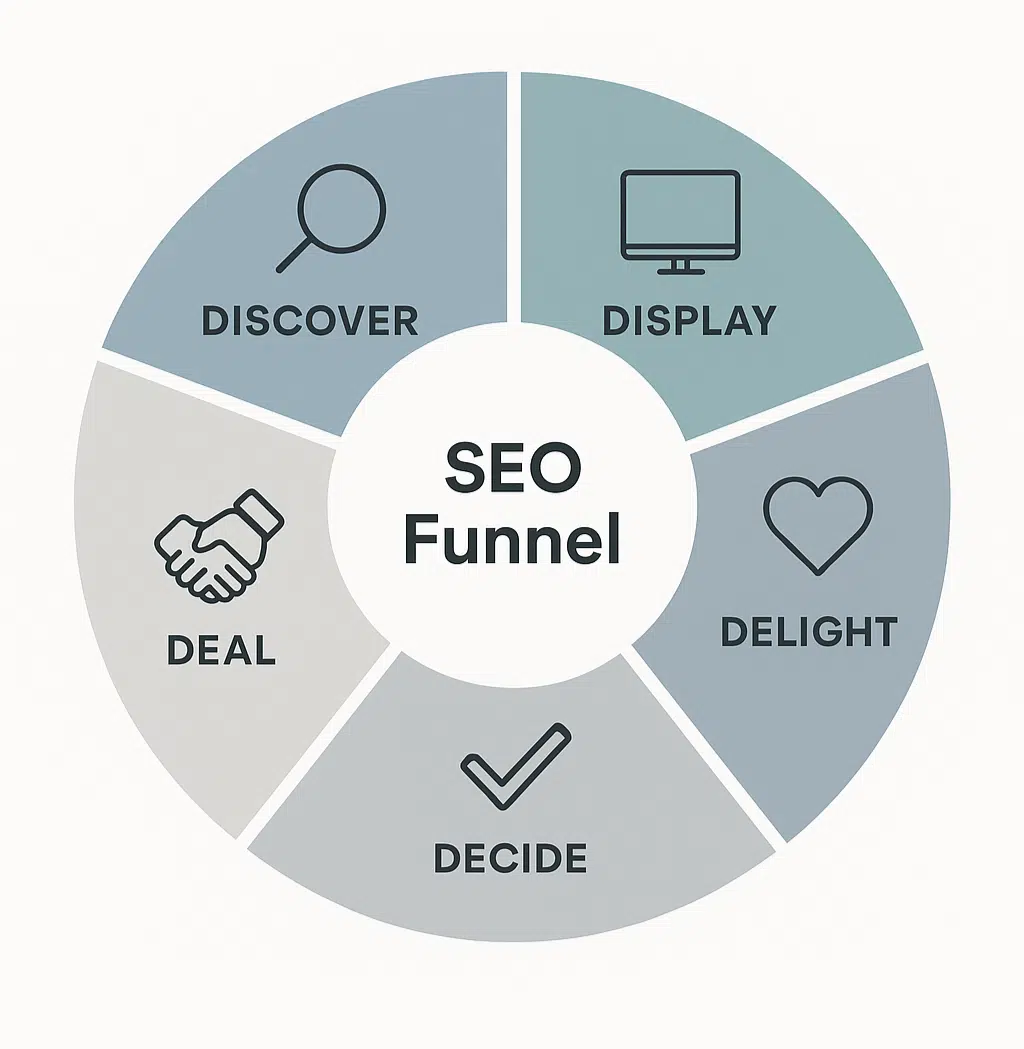
Stage 1: Discover – Crawl & Render Optimization
Before a visitor ever sees your page, Googlebot has to find it. If that sounds obvious, stick with me, it’s the #1 leak in most SEO funnels. Think of this stage like a bouncer at the club. If your content doesn’t load fast, render correctly, or play nice with code, it’s stuck outside watching everyone else get traffic.
In 2025, JavaScript is still a common culprit. If key content only appears after a user interacts or scrolls, Googlebot may never see it, which can radically affect your visibility on pages it should prioritize. Studies show that over half of sites built on JavaScript-heavy frameworks fail to render properly for bots, even when visible to users.
That’s why crawl budget optimization is so important. Google only spends a limited amount of time crawling your site. Waste it on dead ends and orphan pages, and your real content gets ignored.
At Logic Inbound, we treat this like plumbing. The goal is simple: no leaks, no clogs, and everything flows toward pages that convert.
Want to see how this fits into your broader SEO conversion funnel? We cover this as part of our SEO services for growth-focused businesses, especially if your site uses JavaScript, complex plugins, or WordPress themes that slow you down.
Internal linking tips for 2025:
- Link from new pages to high-authority content
- Use short, clear anchor text that matches the topic
- Avoid burying links at the bottom where users (and crawlers) ignore them
- Prioritize pages that drive leads, not just traffic
When you get this right, everything else becomes easier. Google sees your most valuable content first, indexes it faster, and sets you up to show in search features like AI Overviews.
Metrics & Tools to Watch
Want to know if your pages are being crawled and rendered properly? These tools will tell you:
- Google Search Console: Crawl stats and coverage reports
- Screaming Frog SEO Spider: Helps spot broken links and crawl traps
- Log-file analysis: Shows exactly how bots move through your site (techy, but powerful)
Pro tip: If your crawl stats are lower than your page count, it’s time to clean house.
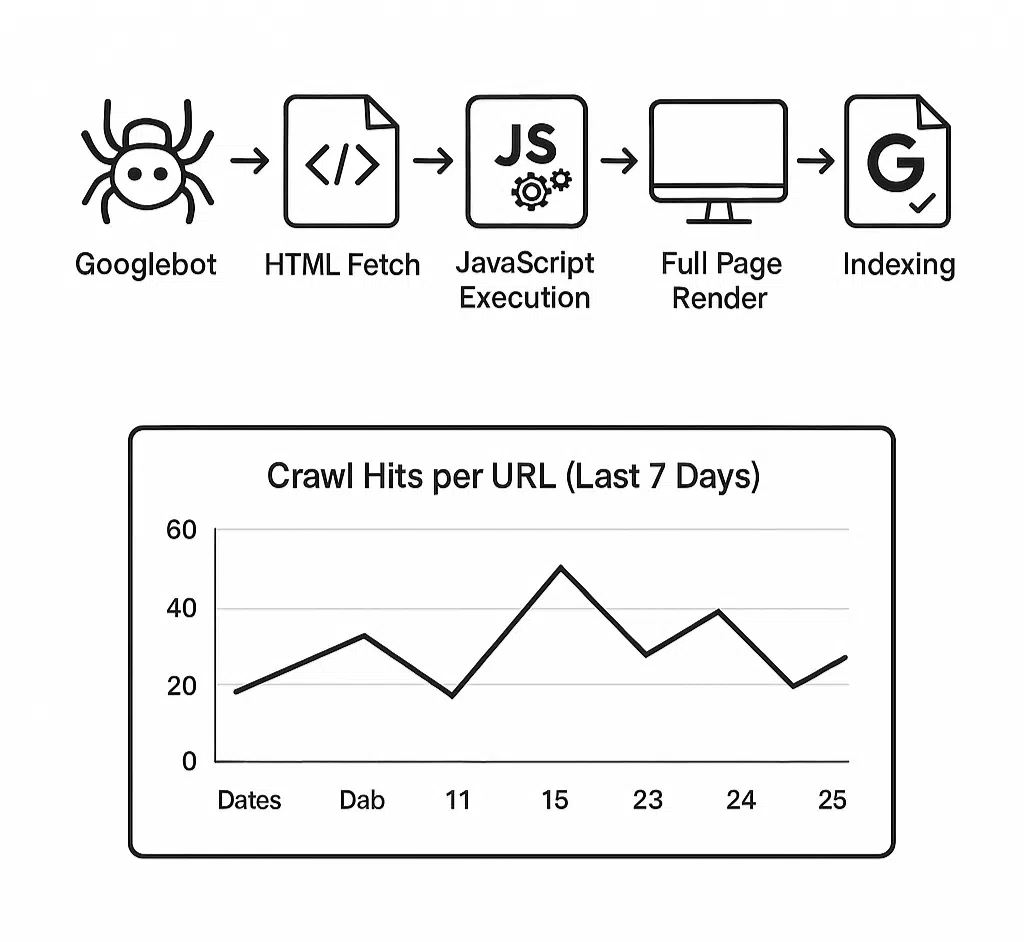
Stage 2: Display – Indexing & AI-Overview Eligibility
So your page is live, your content is solid, and Googlebot can find it. Now comes the next test: Will Google actually index it and show it to users? This stage of your SEO sales funnel is all about visibility. If Google skips over your content in its index, your funnel’s dead before it even begins.
Here’s what gets pages disqualified:
- Duplicate or near-duplicate content (even from your own site)
- Pages without canonical tags or with conflicting ones
- URLs that haven’t been updated in months (Google looks at “lastmod” dates)
- Thin pages with little value (think: 200-word listicles or tag pages)
Even minor content duplication can waste crawl budget and dilute ranking potential, as highlighted in Semrush’s insights on duplicate content.
You could write the best blog post on the planet, but if it doesn’t check Google’s indexing boxes, it won’t rank and definitely won’t show up in AI Overviews.
How to improve indexability:
- Use canonical tags to show which version of a page is the primary
- Keep your sitemap.xml updated and submitted via Search Console
- Use the Indexing API (especially for job or live-event pages)
- Make regular updates to priority content, even small tweaks signal freshness
- Fix thin content or combine it with stronger pages to build topical authority
Adding structured data helps Google understand your content format and improves visibility in rich results, OnCrawl’s guide on schema and rich snippets shows how this can boost your indexing and SERP presence.
Internal tip: At Logic Inbound, we embed schema into all our core SEO pillar pages. It’s helped us win visibility even when competitors had higher backlink counts.
Quick-Win Schema Blocks
Here’s a basic FAQ schema block that’s still valid in 2025. Just paste it into the <head> of your page using a plugin or manual code:
{
“@context”: “https://schema.org”,
“@type”: “FAQPage”,
“mainEntity”: [{
“@type”: “Question”,
“name”: “What is the SEO funnel?”,
“acceptedAnswer”: {
“@type”: “Answer”,
“text”: “An SEO funnel is a structured journey that guides search traffic from awareness to conversion using targeted content and technical SEO.”
}
}]
}
Want to future-proof it? Add a second block for “How-To” schema, especially if you’re targeting step-by-step keywords like how to optimize for AI Overview.
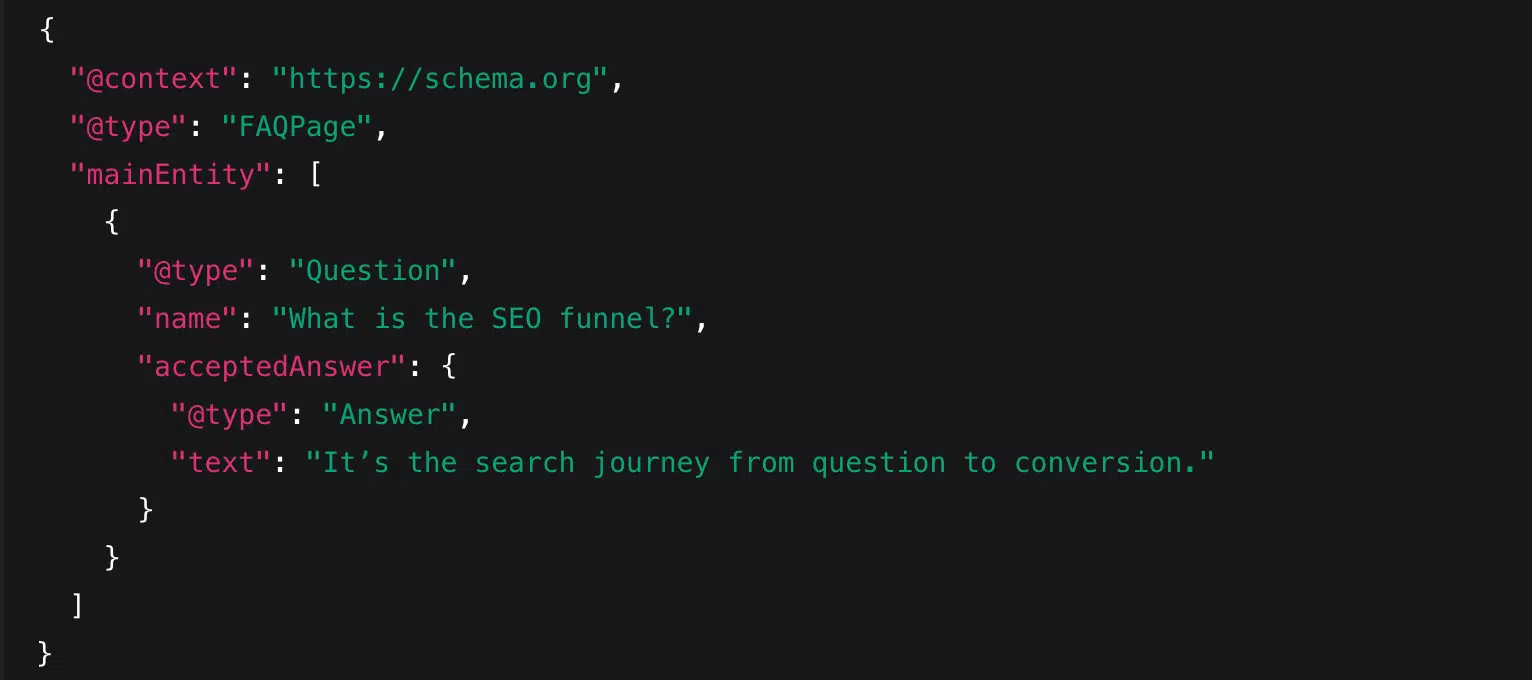
Is Your Content AI-Overview Ready?
Most websites think they’re optimized, but they’re missing key schema, crawl logic, or internal link flow.
✅ We’ll show you exactly what Google sees
✅ Get instant tips to fix indexing issues
✅ Includes AI Overview eligibility checklist
Stage 3: Delight – Earn Visibility & Engagement
This is where your SEO funnel goes from “we exist” to “hey, we’re actually showing up.” But showing up isn’t enough anymore. You have to earn attention. Fast.
At this stage, we’re optimizing for visibility:
- Featured snippets
- Images that get indexed
- Videos that win key moments
- Pages that actually pull people in
This is the top of funnel SEO moment. Your goal? Answer real questions better than anyone else and make it easy for both search engines and people to understand what you’re offering.
In 2025, featured snippets and zero-click results dominate top-of-page real estate. A recent study found that featured snippets capture over 35% of clicks when they appear, a clear sign your content must win the snippet to capture attention.
Quick wins that boost TOFU performance:
- Use headings that sound like real questions
- Answer those questions directly, in the first sentence or bullet
- Add schema markup (especially FAQ, How-To, and Video)
- Make sure every image has descriptive filenames and alt text
- Include short video clips with timestamps so Google can use them for “key moments”
This isn’t just about showing up. It’s about standing out.
Now here’s the real kicker:
Paid ads can actually help your SEO funnel perform better at the top.
When you pair TOFU blog content with targeted Google Ads, you gain extra signals like clicks, engagement, even branded searches and that help boost organic rankings over time.
That’s especially true for businesses in competitive industries, where TOFU content alone gets drowned out. We talk more about this strategy on our Google Ads for local lead generation page.
Don’t sleep on this combo. SEO plus PPC at the top of the funnel isn’t a “backup plan,” it’s fuel for faster growth.
Local/Map-Pack Twist
If you serve a specific city or region, your visibility fight doesn’t stop at organic results. You also need to dominate the Google Map Pack.
In 2025, the top 3 slots in the Map Pack received nearly 44% of all local search clicks, with businesses in those positions seeing triple the engagement compared to ranked listings outside the pack. This underscores why Map Pack visibility is a high-value feature of your funnel.
Google Maps Strategies That Work:
- Increase review volume and velocity
- Use locally relevant keywords in your profile content
- Strengthen “Location Authority” through consistency, ratings, and engagement
Consider Local Services Ads, which appear above the Map Pack and capture high-intent, BOFU traffic
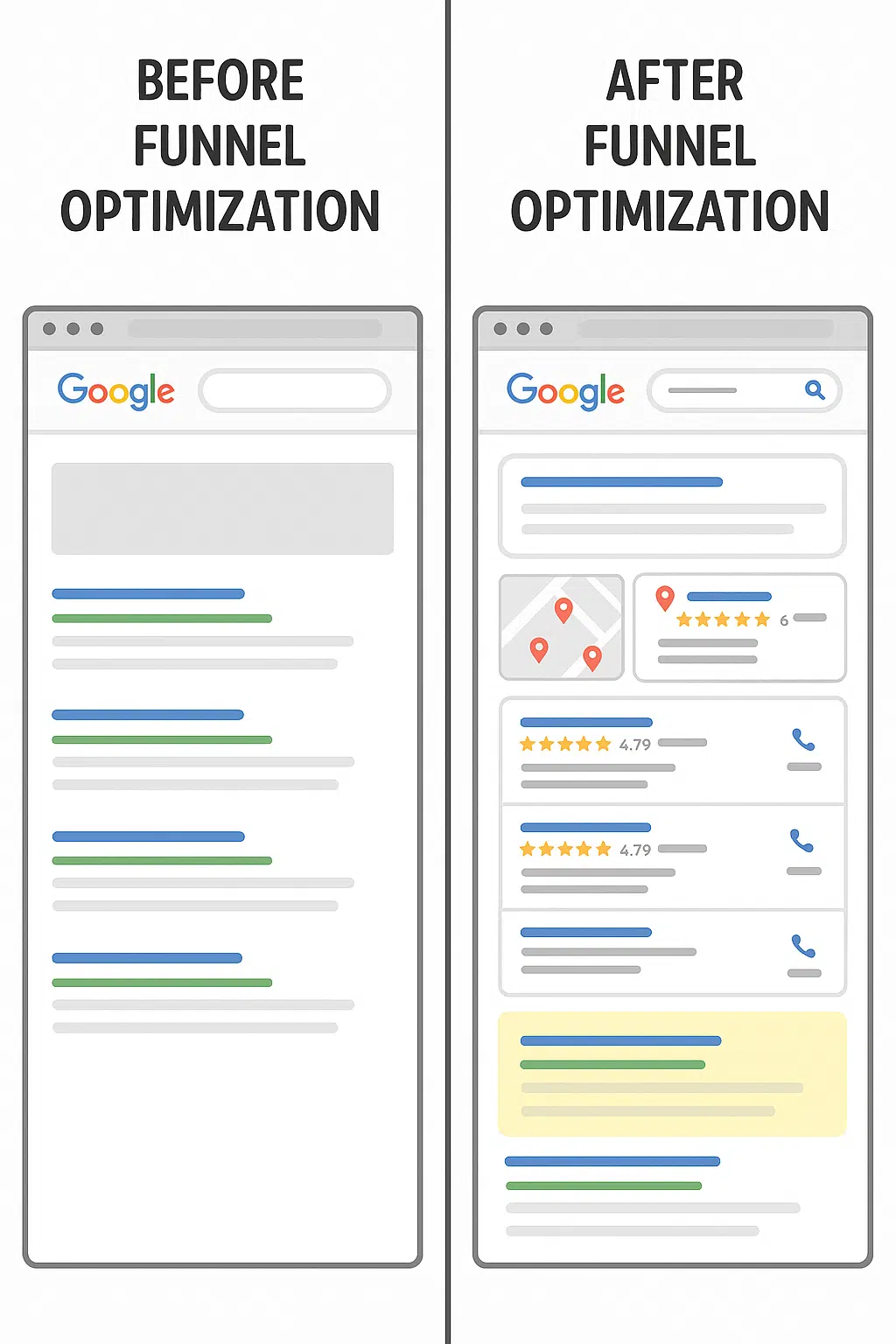
Stage 4: Decide – Convert Clicks to Customers
You’ve earned the click. Congrats, but the work isn’t done. This is the bottom of the funnel moment. If your site fumbles here, you’re not just losing traffic, you’re losing money.
The best SEO conversion funnels don’t just drive visitors. They turn visitors into leads, leads into buyers, and buyers into repeat customers. That all starts with making the decision stage as frictionless as possible.
Here’s what that looks like in 2025:
- Clear, specific CTAs (“Get My Free Estimate,” not “Submit”)
- Short forms with only essential fields
- Trust signals like star ratings, verified badges, or secure checkout icons
- Interactive tools like quote calculators or savings estimators
- Mobile-first layouts (because 70% of your traffic is coming from phones)
This stage isn’t about fancy design. It’s about clarity. People don’t want to think. They want to know exactly what they’re getting and why they should trust you.
Using a specific, clear CTA can increase conversion rates by up to 161%, according to 2025 data from WiserNotify. And placing buttons prominently, especially above the fold, can boost CTR by around 45%.
That’s where case studies become powerful. Showing real-world results beats buzzwords every time. We’ve seen this firsthand at Logic Inbound. One of our clients in the medical space 4X’d their organic leads after we revamped just their BOFU content and form experience.
Want to see the numbers? Check out our featured success stories to see how this strategy plays out in the wild.
And don’t forget, decision-stage SEO still matters. Your product or service pages should target transactional keywords, support structured data (like product or local business schema), and align tightly with the intent of the search.
GA4 Funnel Reporting: How to See Where You’re Losing Customers
You can’t fix what you can’t see. That’s where GA4’s Funnel Exploration report comes in.
Here’s how to build one:
- Go to Explore > Funnel Exploration
- Define each step (e.g., Page View → Form Start → Form Submit → Thank You)
- Filter by source = organic or page = SEO landing page
- Analyze drop-off points and time between steps
You’ll instantly see where users stall, and which pages are silently killing conversions. Set it up once, and it becomes your personal lie detector. No more guessing. Just data.
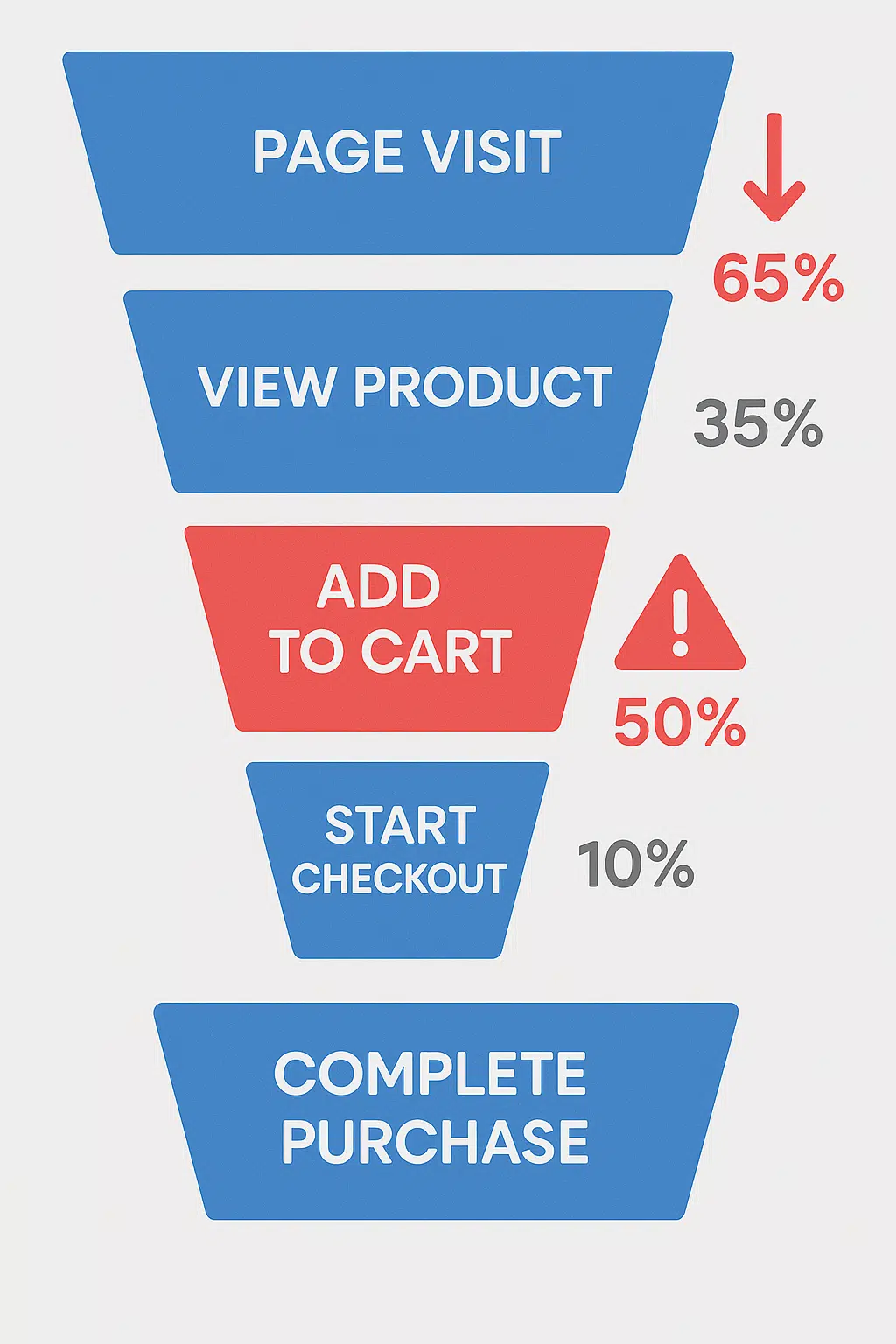
Stage 5: Deal – Retain, Upsell & Amplify
Most businesses treat a lead like a finish line. But in reality, it’s just the starting point of your real growth engine. The smartest brands use the retention stage of SEO to build a flywheel, where every happy customer feeds your traffic, credibility, and revenue over time.
Here’s how.
Step 1: Ask for reviews (the right way)
Don’t just hope someone leaves a 5-star. Make it part of your post-sale process. Set up a simple, mobile-friendly flow: “How was your experience? Tell us in 20 seconds.” Not only does this build trust with future buyers, but reviews directly influence local SEO and Google’s trust signals.
Step 2: Turn buyers into marketers
Encourage user-generated content (UGC). This could be:
- Testimonials
- Before/after photos
- Video walkthroughs
- Social proof tags (especially for eComm and service businesses)
Research from Backlinko shows that websites featuring UGC see up to a 20% conversion boost, proving that real voices carry real weight.
Step 3: Loop back to TOFU
Use segmented email sequences to educate, upsell, or refer new visitors. These nurtured leads re-enter the top of funnel with more intent and often bring friends. It’s like compounding interest, but with content.
And this isn’t theoretical, we’ve used these exact tactics to grow LTV and SEO reach for clients in home services, legal, and healthcare. Retention SEO may not get all the spotlight, but it quietly drives compounding returns over time.
Want help mapping out your own retention system? Start with an SEO plan built around repeat traffic and review growth, something we actively implement for long-term clients.
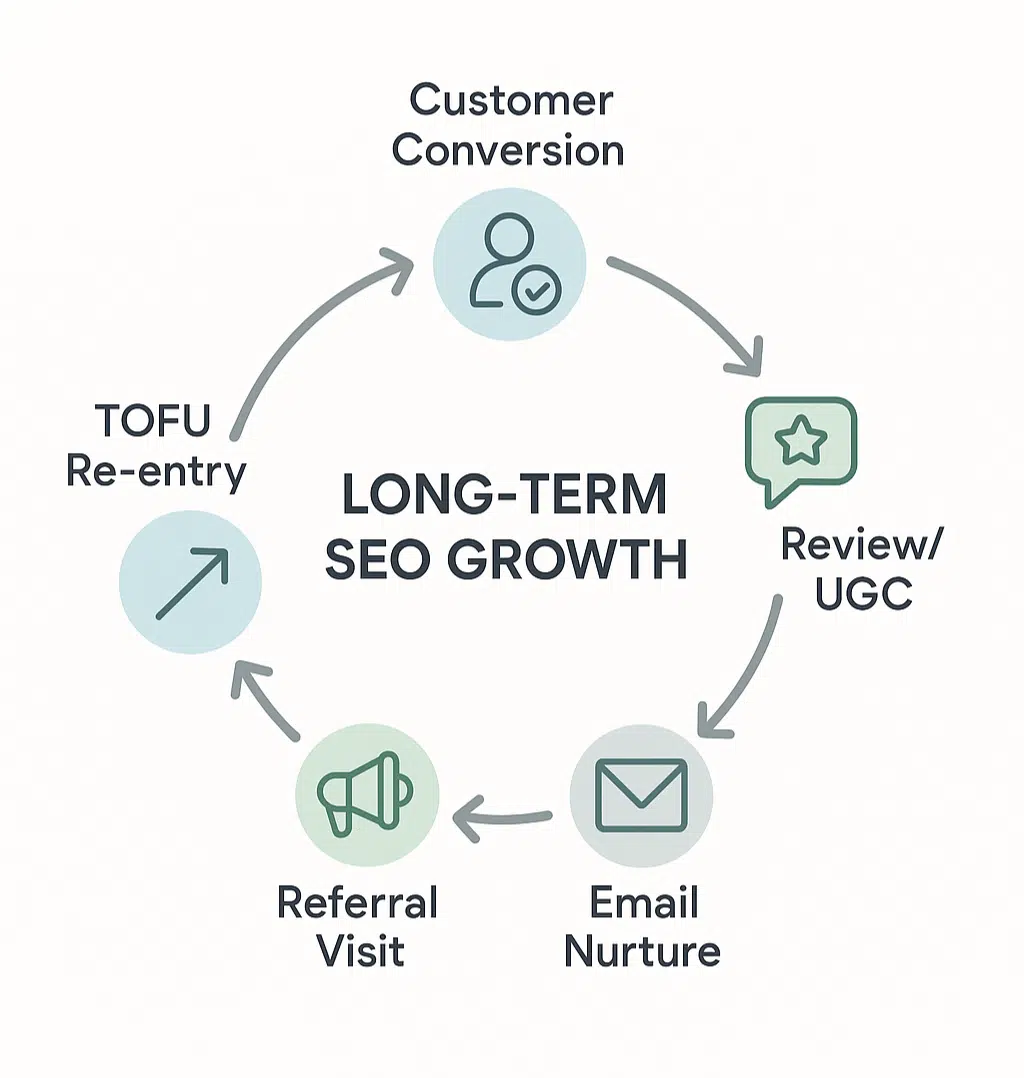
Traditional vs AI-First SEO Funnel
If you’re still running your SEO sales funnel like it’s 2018, you’re already behind. Google’s updates, user behavior shifts, and the rise of AI-generated answers have changed the rules of the game.
Below is a quick SEO funnel template you can use to spot the gaps and start future-proofing your strategy today.
| Funnel Stage | 2018 Approach | 2025 AI-First Approach | Key Metrics |
| Discover | Publish and wait | Crawl/render audits, JS optimization | Crawl stats, index coverage |
| Display | Rely on backlinks | Indexing API, schema-rich content | Indexed URLs, impressions |
| Delight | Blog spam or keyword dumps | Featured snippets, video markup, image SEO | Clicks, snippet wins |
| Decide | Long forms, generic CTAs | CRO-focused pages, calculators, trust signals | Conversion rate, form starts |
| Deal | “Set and forget” customers | Review generation, UGC loops, email nurture | LTV, repeat traffic, reviews |
Want a done-for-you version of this template tailored to your site? We include this in every custom SEO audit at Logic Inbound.
Ready to Modernize Your SEO Funnel?
Stop wasting time on outdated tactics. Let’s map your content and traffic into a revenue-generating system, built for 2025 search.
Next Steps: Get Your SEO Funnel Working for You
If you’re serious about turning clicks into customers, it’s time to put this into action.
We’ll show you exactly where your funnel is leaking and how to fix it fast. Our team can audit your funnel, prioritize the quick wins, and help you scale what’s already working.
Ready to build a system that actually grows your business? Book a free SEO services consultation or explore our conversion optimization strategies to get started.
Let’s turn your traffic into results.
FAQ
- What are the five stages of an SEO funnel in 2025?
In today’s search environment, the five stages of the SEO funnel are:
- Discover: Make sure Google can crawl and render your content
- Display: Get indexed and show up in relevant searches
- Delight: Earn visibility through snippets, images, and video
- Decide: Convert clicks into leads with clean CTAs and forms
- Deal: Keep customers coming back with reviews, UGC, and email follow-ups
It’s not just a content path, it’s a system that connects search behavior to business outcomes.
- How does Google decide which content appears in AI Overviews?
Google’s AI Overviews favor content that’s structured, trustworthy, and fast to understand.
Here’s what helps:
- Directly answering real questions
- Using FAQ and How-To schema
- Having clear subheadings and summaries
- Earning topical authority (not just backlinks)
- Is an SEO funnel the same as a sales funnel?
Not exactly. A sales funnel maps the stages of your customer’s buying journey, awareness, interest, decision, and so on.
An SEO funnel focuses on guiding people through that journey using search content and technical optimization. Think of it as the fuel that powers your sales funnel. Without it, you’re not bringing in enough qualified traffic to convert in the first place.
- Where do GA4 Funnel Exploration reports fit into SEO?
GA4 Funnel Exploration helps you see where users drop off, from pageview to form fill to thank-you page. In the SEO conversion funnel, this data is gold. You can identify which pages leak traffic, fix friction points, and tie performance to actual revenue, not just rankings.
We covered setup steps earlier in the Decide section, but if you want help building a full funnel report, just ask.
- Do local businesses really need a dedicated SEO funnel?
Absolutely, in fact, local businesses are often the ones who benefit the most. Why? Because when someone searches “roof repair near me” or “best dentist in Ballard,” they’re ready to act. But only if they find you and trust you at every step of the journey.
The good news? A well-structured local funnel can outperform national brands if it’s built right. Need proof? Check out how we’ve helped service businesses dominate their markets in our case studies.
Let’s Build You a Funnel That Converts
You made it to the bottom. Let’s make sure your leads don’t. Start with a free consultation and actionable funnel teardown.
